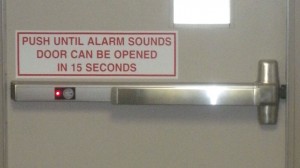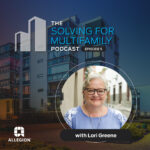Today is the second webinar in the series for access control integrators, so here is my second list of Quick-Tips (the first list can be downloaded here). There have been some changes in the 2015 edition of the IBC, so it’s worth a review.
[Click here to download a printable copy of these tips.]
Purpose – Delayed egress hardware prevents a door from being opened from the egress side, usually for a period of 15 seconds. This type of device is often used to prevent theft or elopement, while maintaining life safety.
Products – Delayed egress locking systems are most commonly comprised of panic hardware incorporating delayed egress features, or an electromagnetic lock and power supply, one of which would contain delayed egress circuitry. When the delayed egress lock is actuated, the door remains locked on the egress side for 15 seconds, and then releases to allow egress.
Code Requirements – The International Building Code (IBC) and NFPA 101 – The Life Safety Code contain similar requirements for delayed egress locks, but there are some slight differences – particularly with regard to the occupancy types where delayed egress locks are allowed.
Use Groups / Occupancy Classifications – In buildings protected throughout by an automatic sprinkler system or automatic fire detection system, approved, listed, delayed egress locks are allowed in the following occupancy types:
- IBC: Delayed egress locks are allowed in any occupancy except Group A (Assembly), E (Educational), and H (High Hazard), but only one delayed egress lock is allowed per egress path. Prior to the 2015 edition of the IBC, one delay was allowed before entering an exit, rather than one delay per egress path. The 2015 edition of the IBC allows two delays per egress path in Group I-2 or I-3 occupancies with a combined delay of 30 seconds, maximum.
- NFPA 101: Delayed egress locks are allowed in buildings containing low- or ordinary-hazard contents, with the following limitations:
- Assembly Occupancies – Only doors other than main entrance/exit doors may be equipped with delayed egress locks. Exception: In airport loading walkways, doors in the egress path from the aircraft into the airport terminal are not permitted to have delayed egress locks.
- Educational / Day Care, Health Care, Ambulatory Health Care, Lodging and Rooming Houses, Hotels and Dormitories, Apartment Buildings, Mercantile, Business, Industrial, Storage – No restrictions in the 2015 edition of NFPA 101. Previous editions limit delayed egress devices to one delay per escape path for some occupancy types. Prior to the 2003 edition of NFPA 101, delayed egress locks in Ambulatory Health Care occupancies were limited to exterior doors.
Initiation – A 15-pound force applied to the egress side door hardware for not more than 3 seconds shall initiate an irreversible process which allows egress in not more than 15 seconds. While NFPA 101 (all recent editions) and the 2015 edition of the IBC allow not more than 3 seconds of applied force to begin the process, previous editions of the IBC included a limit of 1 second to initiate the process.
Audible Alarm – Initiation of the irreversible process must activate an audible alarm in the vicinity of the door.
Rearming – Delayed egress devices must be rearmed manually.
Alarm Release – Doors must allow immediate egress (no delay) upon actuation of the automatic sprinkler system or automatic fire detection system. The IBC also requires the capability of release from the fire command center and other approved locations. NFPA 101 specifies that doors allow immediate egress (no delay) upon actuation of the sprinkler system, not more than one heat detector, or not more than two smoke detectors.
Loss of Power – Doors must allow immediate egress (no delay) upon loss of power controlling the delayed egress lock.
Extension of Delay – A delay of up to 30 seconds (instead of 15 seconds) is allowed when approved by AHJ.
 Signage – Signage is required to be mounted on the door, adjacent to the release device (the IBC specifies above and within 12″ of the door exit hardware), stating: “PUSH [PULL] UNTIL ALARM SOUNDS. DOOR CAN BE OPENED IN 15 [30] SECONDS.” NFPA 101 further specifies a visible, durable sign with letters 1″ high minimum with 1/8″ minimum stroke width on contrasting background. The 2015 IBC has added a requirement for the signage to comply with the visual character requirements of ICC A117.1. The 2015 IBC also includes an exception for Group I occupancies where the care recipients require restraint or containment – installation of a sign is not required.
Signage – Signage is required to be mounted on the door, adjacent to the release device (the IBC specifies above and within 12″ of the door exit hardware), stating: “PUSH [PULL] UNTIL ALARM SOUNDS. DOOR CAN BE OPENED IN 15 [30] SECONDS.” NFPA 101 further specifies a visible, durable sign with letters 1″ high minimum with 1/8″ minimum stroke width on contrasting background. The 2015 IBC has added a requirement for the signage to comply with the visual character requirements of ICC A117.1. The 2015 IBC also includes an exception for Group I occupancies where the care recipients require restraint or containment – installation of a sign is not required.
Emergency Lighting – Required on the egress side of the door.
Certification – The 2015 IBC has added a requirement for delayed egress locking systems to be listed in accordance with UL 294 – Access Control System Units.
You need to login or register to bookmark/favorite this content.





Hi Lori,
For delayed egress solutions especially the one using a maglock, should we need to tie up a backup REX (Request-to-Exit) accessory like break glass with the system in case the primary REX accessory goes malfunction for unknown reasons in order to cut the power for free egress under a panic condition instead of an initiation of power outage through the fire detection system under a fire condition? Please advise.
Hi Paul –
For a delayed egress lock, the IBC and NFPA 101 do not require a separate release device. You could add one to the system, but it’s not dictated by code.
– Lori
Does VD sell a pull version of the sign?